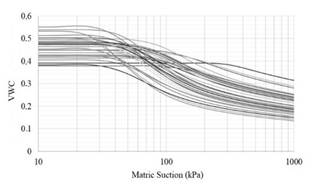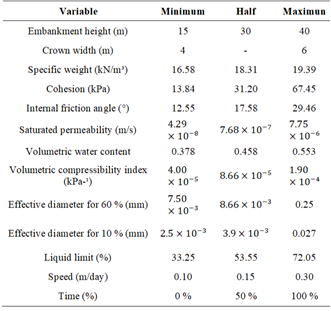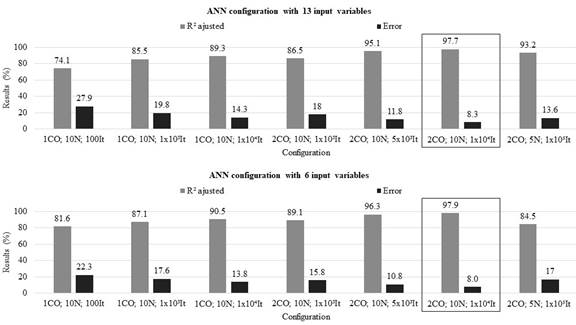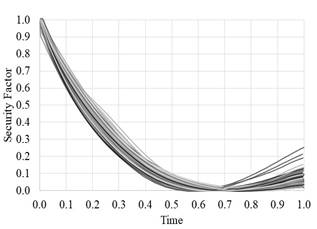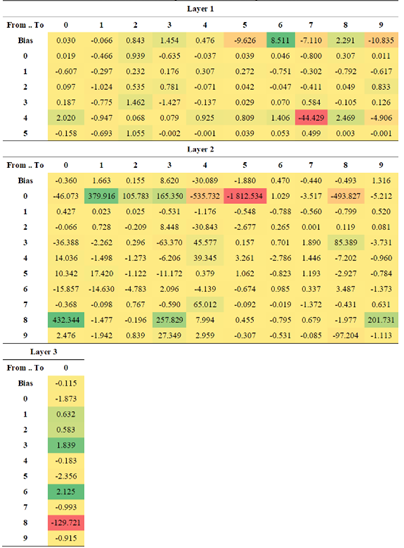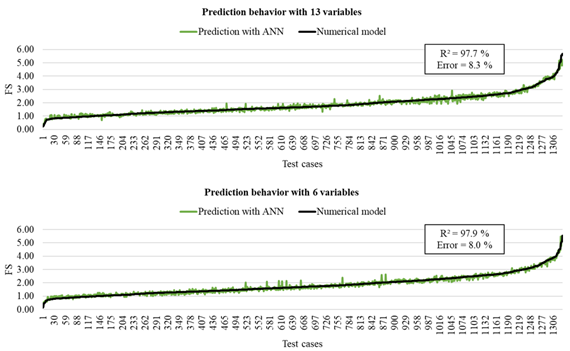1. INTRODUCTION
Since ancient times, the availability of water has been a limiting factor for the development of society, which has forced man to build structures for the use and management of water resources. The dams built around the world represent fundamental solutions to meet this objective (Toapaxi et al., 2015).
The complex behavior of soil and rock as construction materials limits the understanding of their applications in engineering projects. For this reason, engineering designs are based on fundamental principles of simplification, where part of their characteristics is assumed. Sometimes this means that the behavior of the soil is underestimated or overestimated in design work (Shahin, 2016).
Recently, the construction industry has seen a rise in utilizing technological information for data collection and analysis (Shahin, 2016). These results have caused the growth of the use of Artificial Intelligence techniques to solve complex engineering problems (Jong et al., 2021).
In analyzes related to slope stability, Factor of Safety (FS) is the index that allows establishing when a slope is stable or not for certain conditions. When obtaining the FS, only elements related to the properties of soils and geometry of the analyzed structure were originally included. However, in recent years, it has been necessary to add external load elements directly associated with loss of stability of these structures (Alfatlawi et al., 2020; Nanehkaran et al., 2023).
During a period of prolonged drought, the water level of earthen dams is significantly reduced, which in turn causes a decrease in the FS on the upstream slope, if the rate of descent of the water level is large enough. This loss of stability may or may not be associated with collapse phenomena, which would cause other undesirable consequences that could lead to the loss of human lives and material resources (Bongiorno et al., 2015; Flores et al., 2020). The phenomenon of drawdown in dams can also occur due to the careless operation of intake works after the placement of small hydroelectric plants, so that it is essential to review this behavior to prevent failures that could become disastrous (Haramboure et al., 2021). In the transient analysis, the variability of the flow load involved is considered, contrary to what was proposed for steady flow conditions. This variation in loads occurs due to changes in boundary conditions associated with the variation of water levels over time (Alonso & Pinyol, 2016; Boushehrian et al., 2017; Flores et al., 2022).
When considering the loading state caused by rapid drawdown inside the embankment of earthen dams, Boushehrian et al. (2017) study the parameters linked to the dissipation of pore pressures during them. Romer et al. (2019) establishes that the pore pressures within the dam embankment cannot be completely dissipated during the release, a criterion verified by Pinyol et al. (2013). Pinyol et al. (2008) studied the effect of drawdown considering its effect on the degree of saturation, showing a high similarity between the numerical models and the piezometric readings in the dams, in turn, they established a relationship between the water level inside the embankment and the duration of the event.
It should be taken into account that the effect of the drawdown on the FS with respect to the time and duration of the phenomenon, causes a recovery of the FS value, linked to dissipation of pore pressures inside the embankment during drawdown event. To establish a definitive criterion for the cases analyzed all FS results were normalized as a function of time in an interval between 0 (initial moment) and 1 (final moment); as shown in Equation 1. Normalization has shown its usefulness in preprocessing to apply mining techniques, including clustering algorithms, artificial neural networks, and classification (Kim et al., 2014; Patra & Basudhar, 2003; Singh et al., 2023).
Where X N is the resulting normalized value; X is the original value obtained; X min is the minimum value of the data set and X max is the maximum value of the data set.
Traditionally, in the design and construction of earth dams, the critical condition of total saturation is taken into account. However, throughout the useful life of these structures, events appear that put stability at risk and are related to states of partial saturation of soil in the embankment. Rapid drawdown classifies as one of these events. Once the drawdown phenomenon occurs, it is possible to apply the criteria of the unsaturated soil mechanic, describing in a more realistic way the behavior of part of the upstream slope. To model the effect of unsaturated soils on slope stability, it is necessary to include suction as a fundamental variable that describes this behavior, which is represented by the soil characteristic curve (Bhaskar et al., 2022).
Soil characteristic curves are obtained using Aubertin et al. (2003), described in Equation 2.
Where S r is the saturation degree; S c is the saturation degree due to capillary forces and S a * is the limited degree of saturation due to adhesion (S a ) (Equation 3).
Adhesive component is associated with a thin film of water that covers surface of the grain and depends on the basic properties of the material, such as: the negative pressure of pore water in the soil, size of the particles, shape coefficient and porosity. The adhesive component is a limited value, since it is possible that at low suctions the value of S a is greater than 1; so, the bounded value ensures that for S a ≥ 1, S a * = 1 and if S a < 1, S a * = S a (Equation 4)
Where a is the curve fitting parameter, considered as 7 × 10-4 for cohesive soils; ψ is the suction; ψ n is the suction term introduced to ensure a dimensionless component; e is the void ratio of the soil and h co is the average capillary elevation (cm) determined for capillary soils, obtained by Equation 5 for granular soils and with Equation 6 for cohesive soils, referring its remaining variables in Equations 7 and 8.
D 10 is the diameter corresponding to 10 % of the granulometric curve.
Where b(cm
2
) is the parameter associated with the uniformity coefficient for granular soils; C
u
is the uniformity coefficient; LL is the liquid limit;  is the parameter associated with the density for cohesive soils and C
ψ
is the correction coefficient that allows reducing the water content for high suctions, based on that proposed by Fredlund & Xing (1994), obtained through Equation 9.
is the parameter associated with the density for cohesive soils and C
ψ
is the correction coefficient that allows reducing the water content for high suctions, based on that proposed by Fredlund & Xing (1994), obtained through Equation 9.
Where ψ 0 is the initial suction, considered equal to 10-7 cm and ψ r is the suction corresponding to the residual water content at which point an increase in suction will not remove more water from the soil, and is given by Equation 10 for cohesive soils.
From the characteristic curves of unsaturated soils, the hydraulic conductivity functions are obtained using the method of Fredlund et al. (1994), shown in Equation 11.
Where k r (ψ) is the function of hydraulic conductivity with respect to suction; b is the upper limit of integration considered as ln(1 000 000); ψ is the soil suction; e is the Euler natural number (2.71828); y is the dummy integration variable that represents the logarithm of the suction; θ ´ is the derivative of the Fredlund & Xing (1994) model that fits the soil characteristic curve; θ(ψ) is the soil characteristic curve; ψ aev is the air input value to the soil and θ s is the volumetric water content of the soil.
One of the fundamental problems in the study of slope stability in earthen dams using numerical models is the number of independent variables that can be associated with failures (Boushehrian et al., 2017; Haramboure et al., 2021; Komasi et al., 2019), which limits the ability to generalize research when the conditions for which a specific model was generated change.
In recent years, hybrid numerical models have been used, which combine transient water flow analyzes using the Finite Element Method (FEM) with slope stability analysis using any of the Limit Equilibrium Methods (LEM) (Jasim et al., 2017; Vahedifard et al., 2020). However, the need for generalization in the response to highly complex geotechnical problems results in the need to create prediction tools. This new approach has been promoted in recent years by the application of AI algorithms (Beiranvand & Komasi, 2021; Wengang et al., 2023).
The primary link between AI and numerical models is since, to get a machine to operate and return the expected results, it is necessary to carry out a training and testing process, which is directly associated with the numerical models, if a supervised process. AI models, particularly supervised learning models, can be trained with the results obtained from numerical models. In this way, the AI model can become an alternative that can replace costly repeated executions of numerical models.
Currently, the implementation of Artificial Neural Network (ANN) tools for the study of engineering problems, specifically the slope stability, has gained popularity internationally. Various authors (Beiranvand et al., 2019; Flores et al., 2021; Komasi et al., 2019; Nanehkaran et al., 2023; Salazar et al., 2015; Santillán et al., 2014) have used them to predict phenomena associated with slope stability, obtaining relevant results. These studies have shown that ANNs are one of the algorithms with the best results for solving slope stability problems. For this fundamental reason, it is selected to obtain the prediction models proposed in this research.
The construction of ANNs is based on the way biological systems process, where neurons are a set of basic units, in which information is processed to obtain a response. Neurons store information by establishing synaptic weights between the input variables of the system, which results in an iterative process directly linked to its training.
In the present research, ANN structures are implemented to predict the FS in homogeneous earth dams subjected to rapid drawdown processes. Hybrid numerical models are carried out for various conditions that range from the geometry to the speed of the discharge, including the physical and mechanical properties of the component soils of the embankment of the earth dams studied. The fundamental results show a high effectiveness of the ANN models implemented for all established time steps.
The fundamental meaning of this study lies in obtaining tools for predicting slope stability before rapid drawdown processes with ANN combined with the results obtained from numerical modeling. Managing to link during this study to partially saturated soils in the analyses. The variability of the geotechnical properties of soils is a determining element in the need to implement tools of this type given their generalization capabilities.
2. METHODOLOGY
Three fundamental geometries are established for the study, corresponding to dams of 15, 30 and 40 meters high on the embankment. They all have drainage prisms and a foundation considered waterproof and non-deformable, since it is the object of study in the stability analysis.
The behavior of the embankment was studied in 40 different soil variants (Flores et al., 2023), all classified as high or low compressibility clays (CL or CH) according to the Unified Soil Classification System (SUCS), and whose minimum, average and maximum values of the main geotechnical parameters are shown in Table 1.
The characteristic curves of all modeled soils are included (Figure 1), obtained using the method of Aubertin et al. (2003).
From the characteristic curves of unsaturated soils, the hydraulic conductivity functions are obtained using the method of Fredlund et al. (1994).
To define the external load associated with rapid discharge, three speeds of decrease in the water level are established: 0.10 m/day; 0.15 m/day and 0.30 m/day. Consequently, it is considered in all cases that the dams contain the projected normal filling level, which corresponds to the height of the embankment minus three meters of free edge; and they will be unloaded until they are completely empty.
2.1 Database from hybrid numerical models
Construction of the database necessary for the implementation of ANN algorithms is obtained using the results corresponding to numerical models. In this case, a two-dimensional plane strain analysis is used, since the longitudinal displacements are constant and the variation of the strains with respect to the length can be considered null, therefore, the analysis is simplified from a mathematical and computational point of view (Fredlund et al., 2019).
In this research, the computational simulation proposed is a hybrid type. All the analyzes of the transient leaks were obtained using the Finite Element Method (FEM) and the stability studies were obtained by the use of the Morgenstern-Price Method, as one of the most precise among the Limit Equilibrium Methods ( LEM) (El-Hazek et al., 2020; Jasim et al., 2017; Vahedifard et al., 2020). All of the above is done in the GeoStudio (2018) program.
The result of combining three heights for the embankment (15, 30 and 40 meters), with their associated geometric characteristics, as well as 40 combinations of soils and three discharge speeds (0.1, 0.15 and 0.3 m/day) yield a total of 360 models. It is taken into account that the FS were obtained daily and that the relationships between speed and height establish diversity in terms of duration for each case. Finally, the resulting database will have a total of 1.46 × 103 sets of input variables with their respective FS as the response variable.
2.2 Nodal structure applied in KNIME
This section presents a model to estimate the FS from the data obtained using the numerical models previously described. For this prediction, perceptron-type RNA with forward feedback is used. To apply the ANN model, the computational tool KNIME (or Konstanz Information Miner) is used (Anting, 2022; Ganasan et al., 2021), which allows the development of models in a visual environment.
The KNIME program is conceived as a graphical tool and has a series of nodes (that encapsulate different types of algorithms) and arrows (that represent the flow of data) that are displayed and combined in a graphical and interactive way, solving optimization problems using metaheuristics. With the application of various nodes, previously implemented, non-linear problems of a predictive nature can be modeled that can be described with mathematical functions without the need for programming knowledge. To do this, the work structure shown in Figure 2 is established, determinated from the proposal by Achong & Guntor (2021).
Of the total numerical modeling results, 13 input variables are defined and 360 models are obtained. The description of these variables, maximum value, minimum value and average value, are shown in Table 2.
Additionally, a general analysis is included with the 13 initial variables and a simplified analysis maintaining only six variables. The incorporation of a simplified analysis is due to the fact that, on occasions, it is not possible to have all the geotechnical data collected in the initial model. This would imply the impossibility of applying these results in the future.

Figure 2 Implemented work methodology for the use of machine learning in the prediction of FS under rapid drawdown
Therefore, by presenting a simpler model, with fewer input geotechnical variables, a greater possibility of data being available in other cases is more feasible. For all these reasons, the following are selected: height of the embankment, fundamental physical-mechanical properties (specific weight, cohesion and angle of internal friction), speed drawdown and time.
Of the total of the resulting numerical models, 70 % of them are established for training and the remaining 30 % are used to test the ANN models obtained (Beiranvand et al., 2019; Jabbar & Muataz, 2021). This partition is done randomly using a node available in KNIME with this function.
2.3 ANN Calibration
A perceptron-type ANN with forward feedback is used (Bui et al., 2019; Flores et al., 2021; Maneta & Shnabel, 2003; Montoya, 2018; Santillán et al., 2014). The main idea of RPOP is to accelerate the minimization of error in the neural networks learning process by using a local approach for weight-updating that overcomes some negative aspects of the pure gradient-based approach. Initially this node (RPROP) has a default configuration (Riedmiller & Braun, 1993); however, it is necessary to carry out a calibration process to obtain the optimal number of neurons and hidden layers for the phenomenon analyzed as shown in Figure 3.
As shown in Figure 3 the structure resulting from this analysis is composed of 1 × 104 iterations, 2 hidden layers and 10 neurons per layer, for both proposed models. Furthermore, for both configurations with the selected structure, an adjusted coefficient of determination R2 greater than 97 % and errors close to 8 % are obtained. The final structure resulting from this analysis for both proposals is shown in Figure 4. The details and hyperparemeters associated with the implemented RPROP algorithm were described by Riedmiller & Braun (1993).
The error obtained in the training phase was 1.107 for the general model and 1.120 for the simplified model. Based on the criterion established by Riedmiller & Braun (1993), they state that if the error reaches values of up to 1.2, it can be considered a good fit for the trained AN.
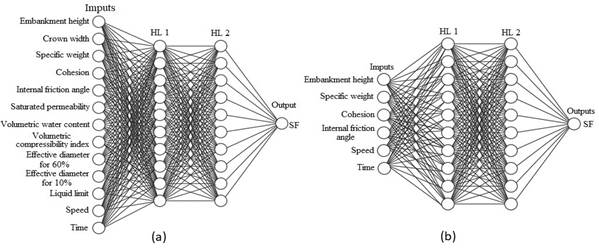
Figure 4 Artificial Neural Network structures implemented for rapid drawdown (a) with 13 input variables and (b) with six input variables
In Figure 5 the decrease in FS during rapid drawdown is abrupt. When up to 20 % of the total time has passed the FS has decreased between 50 % to 60 % compared to its initial value (always greater than 1.5; therefore, it is considered stable and safe). Then between 20 % and 50 % of the total time the decrease in FS reaches values between 60 % and up to 100 % potentially endangering the safety of the slope (if values lower than 1 are reached during the process) with the own repercussions related to its possible failures. However, the maximum recovery of FS does not exceed 30 % of the initial value oscillating mostly below 15 %.
This behavior is sustained for the geometries of 15 and 40 meters of embankment height which is reflected in Table 3, which shows the extreme values of FS recovery as a function of time for all the cases studied.
Additionally, it was observed that for the same geometry, there is a variation in these intervals when the speed of occurrence of the discharge is modified. However, this variation is less than 5 % in all the cases analyzed and for the three speeds considered so it is considered irrelevant for these analyses. From this study, it is recommended to take into account that the recovery interval of the FS during drawdown is wide (around 30 % of the time) a behavior that can be associated with the fluctuation of the physical-mechanical properties of the component soils of the embankment, in particular cohesion, a parameter that presents a high variability in the study despite the fact that all the soils studied are clays with similar classifications (CL or CH).
Predictive models with ANN
Understanding the internal functioning of ANNs and how the model is obtained is extremely complex and currently receives a lot of attention (Barredo-Arrieta et al., 2020). In fact, the field of Explainable AI (XAI) is dedicated to trying to make understandable these models, which achieve high precision but are difficult to understand. For all these reasons, Table 4 shows the results corresponding to the biases and the weights corresponding to the simplified model.
In Table 4, the colors show how the weights and bias are distributed between the neurons of the different layers of the ANN. The intermediate layers of ANNs do not have a predefined meaning, but rather function as hidden characteristic variables that the model detects from the data (Barredo-Arrieta et al., 2020). It is observed (Table 4) that the weights with small values, close to 0 (in yellow) are the predominant ones in the model. In this case, this behavior is observed in the first layer between variable 4 (velocity) and neuron 7. Extremely negative values (in red) mean that the neuron opposes the values taken by the corresponding variable. Extremely positive values (in green) mean that the neuron adds to the values of the corresponding variable. In the first layer there are no high addition relationships between any of the variables. However, in the second layer, these addition relations are presented in variables 0 and 8. As for the third layer (output), the red values of neuron 8 imply that the growth of this variable is inversely proportional to the value of the FS.
Once the training of each of the applied ANN structures has been carried out the test results are shown between the numerical model and the prediction obtained for the configuration with 13 and six input variables (Figure 6).
From the results shown in Figure 6, a good fit between the original values and those predicted by the tool for these analyses can be considered. The robustness of the predictions concerning the results obtained with the numerical model guarantees high precision when applying tools based on Artificial Intelligence such as ANN to solve complex geotechnical problems such as the stability of slopes against the effects of rapid drawdown. Furthermore, the results presented in this research guarantee two approaches: a general one, which includes all the soil parameters involved in the analysis and a simplified one, which is of vital importance, since it is known that it is not always possible to have all the variables geotechnical techniques resulting from soil studies. The nodes trained from this analysis can be used to make other predictions for cases not considered in this research.
4. CONCLUSIONS
Rapid drawdown can be caused by phenomena such as drought or operational changes. Hybrid modeling of this phenomenon to obtain FS on earthen dam slopes allows modeling these transient water flow problems, considering unsaturated soils. In these cases, the reduction of the FS is observed with the consequent loss of stability and safety of the upstream slope.
A meticulous examination of results derived from numerical models enables a discerning evaluation of the fluctuation in FS during rapid drawdown processes, as outlined in the cited literature. This underscores the imperative to delve into the study of this phenomenon and its potential ramifications for the optimal operation of reservoir.
Thorough analyses and numerical normalization within the 0 to 1 scale reveal distinct trends. The rapid decline in FS is notably abrupt, especially within the initial 20 % of the total elapsed time, resulting in reduction of approximately 60 % FS. The pivotal points, marking the minimum FS, occurs within the 50 % to 90 % timeframe of the overall drawdown duration. This phase is followed by a recuperative period, associated with the stabilization of pore pressures within the embankment. Substantially, the FS recovery typically does not surpass 15 % of the previously attained minimum FS.
The intervals of FS recovery exhibit slight variation (less than 5 %) for identical geometries, contingent on the drawdown velocity. Consequently, these intervals are not deemed representative for the analyses. The notable fluctuations in FS recovery values are linked to the variation in the physical-mechanical properties of the constituent soils within the embankment.
After carrying out the corresponding analyses, adjusted R2 determination coefficients greater than 97 % and mean absolute errors close to 8 % were obtained for both applied ANNs. The results show that it is possible to successfully train and test ANN structures for complex geotechnical phenomena, such as the stability of slopes in earthen dams subjected to rapid drawdown.
The results obtained in this research can be used in subsequent research, as well as the trained and tested ANN models. In subsequent research, it is recommended to include other types of AI tools, as well as to study other complex phenomena that unfavorably influence the stability of slopes in dams, such as precipitation.
























